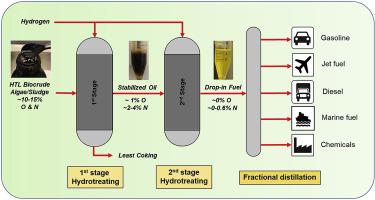Biomass & Bioenergy ( IF 6 ) Pub Date : 2020-06-23 , DOI: 10.1016/j.biombioe.2020.105658 Muhammad Salman Haider , Daniele Castello , Lasse Aistrup Rosendahl

|
Effective catalytic hydrotreatment of highly nitrogenous biocrudes derived from the hydrothermal liquefaction (HTL) of primary sewage sludge and microalga Spirulina biomass was explored. A critical issue is the lack of thermal stability of raw HTL biocrudes at the severe conditions (~400 °C) required for hydrodenitrogenation. This fact suggests the need for a two-stage approach, involving a first low-temperature stabilization stage followed by another one operated at higher temperature. In this study, DSC was successfully used to indicate the thermal stability of both biocrudes. During hydrotreating, it was observed that complete deoxygenation was already achieved in the first stage at 350 °C, with limited coke formation. Moreover, after second stage up to 92% denitrogenation associated with the higher hydrogen consumption (39.9 g kg −1 for Spirulina and 36.9 g kg −1 for sewage sludge) was obtained for both biocrudes. Consequently, comparable oil yields but significantly less coke yields were recorded during two-stage upgrading (1.0% for Spirulina and 0.7% for sewage sludge), compared to direct processing at 400 °C (9.1% for Spirulina and 3.4% for sewage sludge). In addition, the properties of the upgraded oils were enhanced by increasing the temperature in the first stage (310 °C, 330 °C and 350 °C respectively). Finally, the results indicated that remarkable drop-in fuel properties were obtained, with respect to heteroatom (O and N) removal, HHV, and H/C ratio during the two-stage hydrotreatment. Two-stage hydrotreating is therefore proposed as a successful approach for the upgrading of HTL biocrudes with high nitrogen content.
中文翻译:

连续水热液化中高氮生物原油的两步催化加氢处理:稳定化阶段的合理设计
有效催化加氢处理源自初级污水污泥和微藻螺旋藻的水热液化(HTL)的高氮生物原油探索了生物质。一个关键问题是在加氢脱氮所需的严酷条件下(约400°C),原始HTL生物粗品缺乏热稳定性。这一事实表明需要采用两步法,其中包括第一个低温稳定阶段,然后是另一个在较高温度下运行的阶段。在这项研究中,DSC已成功用于指示两种生物原油的热稳定性。在加氢处理过程中,观察到第一阶段在350°C时已经实现了完全脱氧,形成的焦炭有限。此外,在第二阶段之后,高达92%的脱氮与更高的氢消耗量相关(螺旋藻为39.9 g kg -1,螺旋藻为36.9 g kg -1两种生物原油均获得了污水污泥。因此,与在400°C的直接处理(螺旋藻9.1%和污水污泥3.4%)相比,在两个阶段的升级过程中,油品产量可观,但焦炭收率却显着降低(螺旋藻1.0%,污水污泥0.7%)。 。另外,通过提高第一阶段的温度(分别为310°C,330°C和350°C),可以提高提质油的性能。最后,结果表明,在两级加氢处理过程中,就杂原子(O和N)的去除,HHV和H / C比而言,获得了显着的直接燃料性能。因此,提出了两步加氢处理作为升级含氮量高的HTL生物原油的成功方法。



























 京公网安备 11010802027423号
京公网安备 11010802027423号